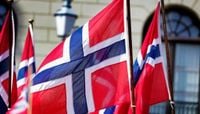Norwegian F-35 fighter jets are once again taking to the skies over Poland, marking a renewed commitment by NATO to bolster air defense on its eastern flank as tensions with Russia remain high. Beginning in October 2025, pilots from the Royal Norwegian Air Force’s 332nd Squadron will be stationed near Poznań, Poland, ready to intercept and, if necessary, shoot down Russian drones or aircraft that violate Polish airspace—a move that underscores the alliance’s determination to protect its member states from aerial threats.
According to Polskie Radio 24, this marks Norway’s second such mission in 2025. The first deployment ran from January through the summer, after which the Netherlands took over, sending their own fifth-generation F-35 jets to Poland. Now, as autumn arrives, Norwegian F-35s are returning to share the skies with Dutch and Polish aircraft, forming a formidable multinational shield over NATO’s eastern border.
Deputy Minister of Defence of Norway, Andreas Flåm, explained the mission’s significance in a statement to the Polish Press Agency: “The North Atlantic Alliance has warned Russia not to escalate the situation. Our mission in Poland will primarily be to defend NATO territory from aerial threats. We will be ready to intercept objects that violate Polish airspace.” Flåm stressed that while Norwegian pilots are prepared for rapid response, the ultimate decision to engage rests with NATO’s Supreme Allied Commander Europe, who will weigh the circumstances of each incident. “The command has numerous tools at its disposal to prevent aerial provocations,” he added.
This heightened vigilance follows a series of alarming incidents in recent weeks. On the night of September 10, 2025, approximately 20 Russian drones—most launched from Belarus—entered Polish airspace during a large-scale air assault on Ukraine. Polish Prime Minister Donald Tusk reported 19 separate intrusions that night, with air defense forces managing to shoot down four drones. The remainder were detected across 11 locations, including one that landed on a military base. Some media outlets, including Polskie Radio24, suggested that several drones may have been targeting a NATO base.
The incursion prompted swift diplomatic and military responses. NATO invoked Article 4, which allows member states to convene and discuss threats to their security. Secretary General Mark Rutte praised the alliance’s coordinated actions, calling them “very successful” and reiterating NATO’s readiness to defend “every inch of territory, including airspace.” In the wake of these events, NATO launched Operation Eastern Sentry on September 13, 2025, a new initiative designed to further strengthen the defense of Europe’s eastern flank.
The arrival of Norwegian F-35s is part of a broader pattern of increased allied military presence in countries bordering Russia. “We have strengthened surveillance and deterrence on the eastern flank. Allied military presence in countries bordering Russia has significantly increased,” Flåm noted. Surveillance and deterrence measures now involve not only Norwegian and Dutch F-35s but also Polish F-16s, all working in concert to monitor and secure the region’s airspace.
This multinational air policing effort has already yielded tangible results. During the previous Norwegian mission, Dutch F-35s—stationed in Poland—joined Polish F-16s in intercepting and neutralizing Russian drones that repeatedly violated Polish airspace. In a notable incident, an F-35A from the Royal Netherlands Air Force, tail number F-027 and belonging to the 313th Squadron, successfully destroyed a Russian drone for the first time. According to Polskie Radio 24, this demonstrated not only the effectiveness of the alliance’s rapid response capabilities but also the growing sophistication of air defense coordination in the region.
The current deployment sees Norwegian pilots stationed near Poznań, with the first two jets of the 332nd Squadron arriving on October 2, 2025. Their mission, as outlined by Norwegian officials, is clear: maintain constant readiness to defend NATO airspace against any unauthorized incursions. The pilots’ rules of engagement, however, remain tightly controlled. As Flåm emphasized, “The Commander of NATO’s Joint Forces in Europe will make decisions on appropriate measures in each specific situation.” This careful balance between vigilance and restraint is designed to prevent escalation while ensuring a robust defense posture.
Contextualizing these developments, it’s clear that the renewed Norwegian deployment is not occurring in isolation. The alliance’s eastern flank has seen a significant uptick in military activity and cooperation since the start of 2025. In July, when the Netherlands assumed responsibility for the air policing mission, their F-35s began regular patrols over Eastern Europe, a rotation that will continue through December 1, 2025. Now, Norwegian and Dutch jets will operate side by side, further enhancing NATO’s ability to respond to evolving threats.
Meanwhile, the Polish government has taken additional steps to reinforce its own borders. President Karol Nawrocki recently signed a resolution authorizing the deployment of armed forces to assist the border guard service along the frontiers with Germany and Lithuania. This deployment, set to last from October 5, 2025, to April 4, 2026, reflects growing concerns about the security of NATO’s external borders amid persistent drone and aircraft intrusions.
For Poland and its allies, the stakes could hardly be higher. The proximity of the Polish border to both Belarus and Russia makes it a frontline state in NATO’s ongoing efforts to deter aggression and maintain stability in Eastern Europe. The repeated violations of Polish airspace by Russian drones—particularly those suspected of targeting NATO installations—have heightened anxieties across the alliance. In this tense environment, the presence of advanced F-35 fighters, with their cutting-edge stealth and sensor capabilities, sends a clear message of resolve.
Yet, as officials repeatedly stress, the alliance remains committed to avoiding unnecessary escalation. The decision to engage hostile aircraft or drones will always be weighed carefully by NATO’s command structure. The goal is to deter further provocations while preserving peace and security for all member states. As Secretary General Rutte put it, the alliance stands ready to defend “every inch of territory”—a promise that, for the people of Poland and the rest of NATO, offers both reassurance and a reminder of the enduring importance of collective defense.
With Norwegian F-35s now back in Polish skies and Operation Eastern Sentry underway, NATO’s vigilance on its eastern border is at an all-time high. The months ahead will test the alliance’s ability to balance deterrence with diplomacy, but for now, the message from Poznań and beyond is unmistakable: NATO is watching, and it is ready.




